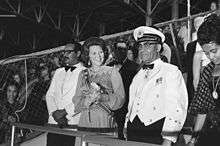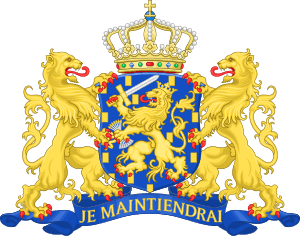Netherlands–Suriname relations
 | |
Netherlands |
Suriname |
|---|---|
Netherlands–Suriname refers to the current and historical relations between the Netherlands and Suriname. Both nations share historic ties and a common language (Dutch) and are members of the Dutch Language Union.
History
Dutch colonization

In February 1667, Suriname became a Dutch colony ( that became known as Dutch Guiana) after the signing of the Treaty of Breda between the Netherlands and the United Kingdom which ended the Second Anglo-Dutch War. In exchange for sugar-rich Guiana, the Netherlands surrendered New Netherland (in present-day United States) to the British.[1] Immediately, the Dutch West India Company became partial owner of the colony and began importing slaves from West Africa to work on the sugar, cotton, coffee and indigo plantations in the colony.[2] Dutch Guiana became the most important colony in the Americas for the Netherlands after the loss of Dutch Brazil in 1654. In the 1700s, many African slaves known as Maroons began escaping to the south of the colony and creating their own tribes and began a small uprising against Dutch rule. In 1762, the Maroons won their freedom and signed a treaty with the Dutch Crown to acknowledge their territorial rights and trading privileges.[3]
From 1799-1816, Dutch Guiana became a British colony after the Netherlands became part of the First French Empire under Napoléon Bonaparte. After the end of the Napoleonic Wars, the Netherlands regained its independence and Dutch Guiana was returned to the Dutch. In 1863, the Dutch ended the slave trade and in need of new labor, began importing Javanese people from the Dutch East Indies (Indonesia) and from India and China to work in Dutch Guiana as indentured laborers. At the same time, several thousand poor Dutch farmers left the Netherlands to work in the colony.[2] By the early 20th century, production in Dutch Guiana moved to rubber, gold and bauxite, the latter becoming the biggest export of the colony (used for the production of aluminum).
Independence
During World War II, Dutch Guiana was host to U.S soldiers after the Netherlands was invaded by Germany in 1940 and the Royal family fled to exile in Canada. In 1942, Prince Bernhard, husband of Dutch Crown Princess Juliana visited the colony. In 1943, Crown Princess Juliana paid a visit to Dutch Guiana.[4] Several primarily white Dutch Guianans fought for the Liberation of the Netherlands during the war.[4] Dutch Guiana became an important provider of bauxite for the war.
At the end of World War II, the Netherlands began providing more autonomy to Dutch Guiana and in December 1954 the Charter for the Kingdom of the Netherlands came into affect which granted Dutch Guiana full autonomy within the nation, except in areas of defence, foreign policy, and nationality. After the independence of the Dutch colony of Indonesia, the Netherlands searched for ways to grant independence for its colonies in the Americas as maintaining the colonies was too costly. In 1973, Dutch Prime Minister Joop den Uyl declared that its last remaining Dutch colonies would be independent during his administration, however, only Dutch Guiana seemed motivated for independence. On 25 November 1975, Dutch Guiana obtained its independence and changed its name to "Suriname". Crown Princess Beatrix of the Netherlands and Prime Minister Uyl were in attendance at the independence ceremony in Paramaribo.
Post Independence
Soon after Suriname obtained its independence, most Europeans returned to the Netherlands and around 300,000 Surinamese also decided to move to Europe and take Dutch citizenship.[2] In February 1980 Dési Bouterse, head of the Surinamese military, staged a violent coup d'état against Prime Minister Henck Arron and Bouterse became de facto military leader of the nation. In December 1982, 15 prominent young men, most of them journalists and lawyers, criticized the military dictatorship of Bouterse. These 15 men were rounded up and taken to Fort Zeelandia (the then headquarters of Bouterse) where they were tortured and killed. The incident became known as the "December murders". As a result of the murders, the Netherlands froze all development aid to Suriname.
From 1986-1992, Suriname was embattled in a civil war known as the Surinamese Interior War against mainly Maroon fighters. In 1986, the Netherlands planned an invasion of Suriname to remove Bouterse from power, however, it was called off at the last minute.[5] In 1999, Bouterse was convicted in absentia by a court in the Netherlands to 11 years imprisonment for drug trafficking.[6] In 2007, Bouterse was charged with for the December murders.[7] In 2010, Bouterse became President of Suriname and therefore immune to prosecution. Since his return to power, the Netherlands has had limited contact with the Surinamese government and has stated that Bouterse is not welcome in the Netherlands.[6] In 2013, the Netherlands called for the arrest of Bouterse in South Africa where he was attending the funeral of Nelson Mandela.[8]
State visits

Royal and Prime Ministerial visits from the Netherlands to Suriname[9][10][11]
- Prince Bernhard of Lippe-Biesterfeld (1942)
- Crown Princess Juliana of the Netherlands (1943)
- Queen Juliana of the Netherlands (1955, 1978)
- Crown Princess Beatrix of the Netherlands (1975)
- Prime Minister Joop den Uyl (1975)
- Prime Minister Jan Peter Balkenende (2005, 2008)
Presidential visits from Suriname to the Netherlands[11]
- President Johan Ferrier (1977)
- President Ronald Venetiaan (2006)
Trade
In 2016, trade between the Netherlands and Suriname totaled 174 million Euros.[12] Dutch exports to Suriname include: chemical based products, machinery, electrical and transport equipment. Surinamese exports to the Netherlands include: live animals and food, raw materials and beverages.[12] The Netherlands ranks second among countries from which Suriname imports goods and services, after the United States.
Diplomatic missions

- Netherlands has an embassy in Paramaribo.[13]
- Suriname has an embassy The Hague and consulates-general in Amsterdam and in Willemstad, Curaçao.[14]
See also
References
- ↑ History of Suriname
- 1 2 3 CIE - Centre for International Heritage Activities: Netherlands-Sruiname Historical Relations
- ↑ Maroon Uprisings in Surinam
- 1 2 Suriname in World War II
- ↑ Netherlands was on verge of invading Suriname in 1986
- 1 2 Returned to Power, a Leader Celebrates a Checkered Past
- ↑ SURINAME-COURT-Prosecutor demands 20 year jail term for President Desi Bouterse
- ↑ Netherlands wants President Desi Bouterse arrested in South Africa
- ↑ Royal Visits of Prince Bernhard and Princess Juliana to Suriname
- ↑ Koningin Juliana bezoekt Suriname – 1955 (in Dutch)
- 1 2 Visits between the Netherlands and Suriname
- 1 2 Handel en economie Suriname (in Dutch)
- ↑ Embassy of the Netherlands in Suriname
- ↑ Dutch Ministry of Foreign Affairs: Suriname
